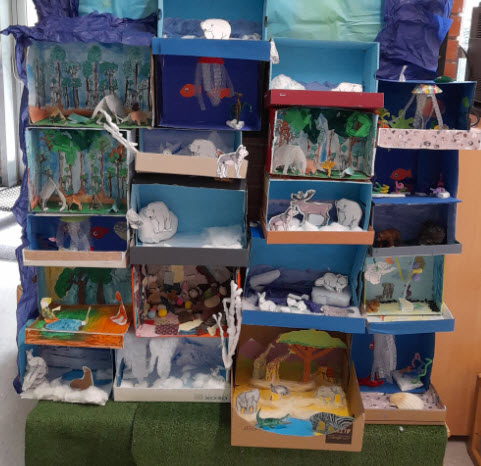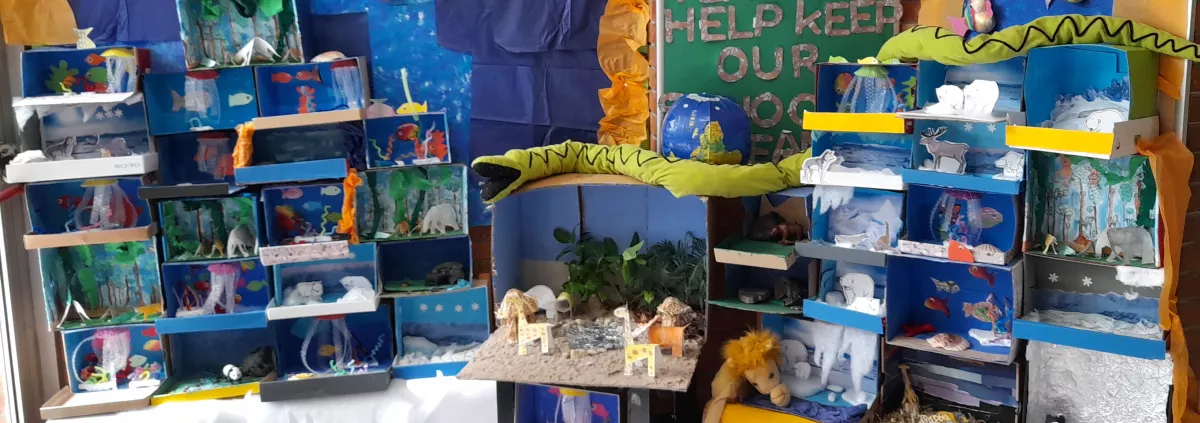How do you teach your young children to look after the environment? How can we as educators help them understand the importance of protecting natural habitats?
All children adore animals and love learning about how and where they live. The question is do they understand that their natural habitats are threatened. How can we raise awareness to this global issue?
Our Happy Habitat project in pre-school lasted for two weeks in total. Prior to starting it, my children had taken part in various recycling projects to raise their awareness about our part in keeping the planet green and clean. Teaching young children to care for the planet is a vast topic and one which needs to be tackled in a very sensitive manner. My children grasped the fact that they can play a part in looking after the planet by recycling, reducing and re-using various things. They also acquired an understanding of global warming notably through songs, videos and experimentation (we used a plastic globe and created steam to illustrate atmospheric pollution).
Identifying habitat groups
We started the Happy Homes project by dividing plastic animals into habitat groups. The children were full of enthusiasm, and we discussed what the animals ate, where they slept, whether they lived in a hot or cold habitats or on land or in water. The children located the animals’ natural habitats on a big map, and we even went on a couple of virtual tours (on Youtube: Arctic, Walking through the woods and Ocean) so they could see how incredible the natural world is.
The Happy Habitat project can be planned as a class activity or as in our case it could involve several classes. Our nursery school classes all chose different habitats.
Choosing a habitat: the Arctic
My class chose to learn about the Arctic. The children learnt about the characteristics of animals who can survive in sub-zero temperatures and how they adapt to their environment. They were curious to learn how animals can swim in freezing water and how blubber protects them from feeling cold (we did an experiment with one hand wrapped up in bubble wrap and the other without any protection and the children held pieces of ice to observe the difference). Their questions were endless, and their curiosity seemed to have no end.
Constructing a Diorama using shoe box
Dioramas are 3-D model which show a scene, in our case a natural environment. They are fun, hands-on projects for children to create and they give a lot of scope for children to explore materials and think creatively in small groups.
I presented the children with an empty shoe box and asked them how we could make it into to an arctic habitat. I invited the children to choose which animals they would like to include and select the materials they could use to represent the ice, snow, trees, water, etc. Whilst assembling the dioramas the children discussed the elements they needed and whether their animals would be happy in the home they were creating. They spent a long time planning and discussing what they needed, and they brought in lots of materials from home to make their Arctic diorama.
Thinking about protecting the planet with young children
Young children cannot be expected to fully grasp the severity of the environmental issues we face, but they can begin to acknowledge that their actions, however small, play a huge part towards saving the beautiful planet we all share.
Whilst constructing their dioramas, I re-introduced the theme of protecting the planet and questioned how their polar bears would survive if the icy terrain melted or where the baby seals would play if the snowy areas became significantly smaller. I could also assess the children’s knowledge about specific animals, and they told me how animals adapt to their habitat.
Exhibiting the Happy Habitat shoe boxes
We displayed all the Happy Habitat dioramas together as an exhibit for the annual Art exhibition.
This activity contains helps implement several dimensions of the GreenComp such as embodying sustainability values and it embraces the complexity in sustainability.



This is a nice learning design to develop sustainability competence, as defined by GreenComp.
https://joint-research-centre.ec.europa.eu/greencomp-european-sustainab…
I would say that it fosters the areas and competences:
- Embodying sustainability values -> promoting nature ("To acknowledge that humans are part of nature; and to respect the needs and rights of other species and of nature itself in order to restore and regenerate healthy and resilient ecosystems").
- Embracing complexity in sustainability -> systems thinking ("To approach a sustainability problem from all sides; to consider time, space and context in order to understand how elements interact within and between systems").
- Acting for sustainability -> collective action ("To act for change in collaboration with others").
Please log in or sign up to comment.